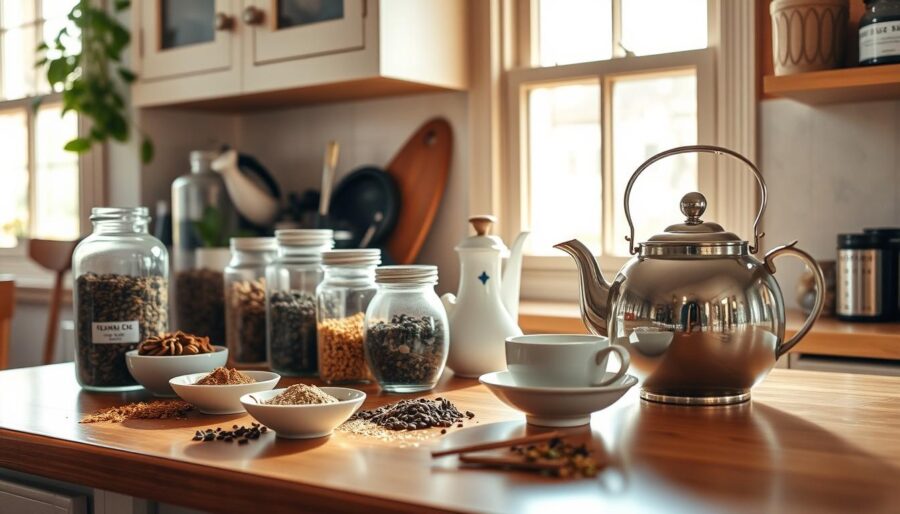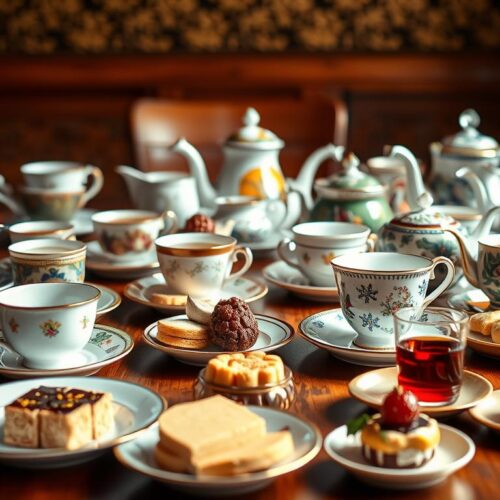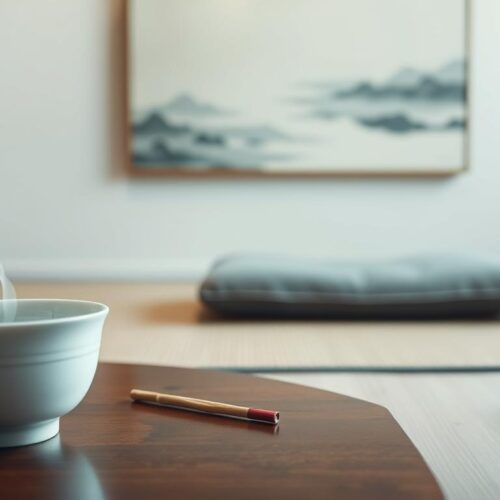Welcome to DIY tea blending! Here, you’ll learn to make your own loose leaf tea blends at home. Tea has a rich history, loved for its flavors and health perks. We’ll show you the tools you need, teach you blending basics, and help explore blends that suit your taste. It’s your opportunity to craft a special herbal blend just for you. Start your flavorful adventure now!
Understanding the Basics of Tea
To make the perfect tea blend, it’s key to know the basics well. All true teas come from the Camellia sinensis plant, offering many flavors and types. The main kinds include black, green, white, and oolong teas. These differ because of how they are processed and where they grow.
Things like flavor, smell, and color impact how teas mix together. For example, black tea is strong and malty, while green tea is lighter and grassy. Knowing these differences helps you mix teas to get a good balance and a great taste.
Herbal teas, or tisanes, are different. They’re made from herbs, spices, and flowers and don’t have caffeine. They give you more options for blending, adding new flavors and health perks to your tea.
Learning about tea’s history makes you enjoy it more. Tea has been grown and loved for thousands of years, with each culture having its traditions. Knowing tea’s backstory helps you understand and mix different types better, for more enjoyable flavors.
| Type of Tea | Flavor Profile | Caffeine Level |
|---|---|---|
| Black Tea | Robust, Malty | High |
| Green Tea | Vegetal, Fresh | Moderate |
| Oolong Tea | Floral, Creamy | Moderate to High |
| Herbal Tisanes | Diverse, Varies | Caffeine-Free |
Essential Tools for DIY Tea Blending
Starting your DIY tea blending journey requires some key tools. Begin with airtight containers to keep your blends fresh. A digital scale is also crucial for getting your recipes just right. To brew your tea properly, you’ll need strainers like tea balls, mesh bags, or cloth filters.
Using a mortar and pestle, you can crush spices and dried herbs to release their flavors. If you want to use fresh ingredients, consider getting a dehydrator to dry herbs and fruits. Clear jars are great for storing your blends and showing them off to friends or as gifts.
Quality tools make a big difference in tea blending. With a complete set of these essential tools, you’re ready to experiment with unique flavors. Pick tools that suit your personal taste for a fun and fulfilling tea blending experience.
How to Choose Your Ingredients
Choosing the right ingredients is key to making great tea. Start by picking a base tea that matches the taste you want. Chamomile, rooibos, or green tea are all good starting points. Then, add accent herbs to improve the smell and taste.
For an extra special touch, include herbs like ginger or turmeric. They add flavor and health benefits. Mix different tastes like fruity or floral to find what you like best.
Feel free to change the amounts to suit your taste. This way, you’ll create tea blends that are uniquely yours to enjoy and share.
Techniques for Blending Tea
Mastering how to blend tea well is crucial for creating perfect tea mixes for your taste. Start with choosing your main tea. It could be a strong black, a light green, or a scented herbal tea. Measure your ingredients with care to keep the balance. Usually, you’ll want three parts of your main tea, one part accent flavors, and one part helpful herbs. This mix lays a good foundation for your tea blend.
To start blending, mix everything really well. This ensures all flavors mix evenly, making your tea taste better. By tasting as you blend, you can change the mix to get it just right. After making a good mix, try steeping a small bit to check its taste. This may show if you need to adjust your tea mix further.
Try different ways of blending to find what tastes best to you. Sometimes, certain mixes might surprise you with how good they taste. Keep trying new blends, and use what you learn from each tasting to get better gradually.
Popular Tea Blends and Recipes
Diving into popular tea blends can make your own herbal tea mixing more fun. It can spark your creativity in making teas. Below are famous recipes to kick off your blending adventure:
- Calming Chamomile Lavender: Combine 3 parts chamomile, 1 part lavender, and 1 part lemon balm for a soothing experience.
- Citrus Mint Digestive: Mix 3 parts peppermint, 1 part lemon balm, 1 part orange peel, and 1 part fennel seed to help with digestion.
- Warming Ginger Spice: For a cozy tea, mix 3 parts rooibos, 1 part ginger root, 1 part cinnamon, and 1 part turmeric.
These blends not only taste different but also offer specific benefits for your health. Trying out various ingredients and ratios lets you make unique teas. Find the blend that’s just right for you.
The Health Benefits of Blending Your Own Tea
Making your own tea blends leads to health benefits of tea just for you. You get to pick ingredients that meet your health needs, improving both taste and benefits. Custom blends also let you add healing herbs.
Ginger, for instance, is great for digestion. Peppermint can soothe nausea well. Chamomile is awesome for relaxation and better sleep. Mixing your own tea lets you use these herbal tea benefits for your health.
Blending your tea means you control what goes in it. Many teas you buy have extra stuff that lessens their health effects. By making teas at home, you enjoy all the DIY tea health advantages. You choose pure herbs and decide how much to use for your health and taste.
Trying different herbs makes drinking tea more fun and connects you to your health. Be in charge of what you drink and enjoy your own tea creations.
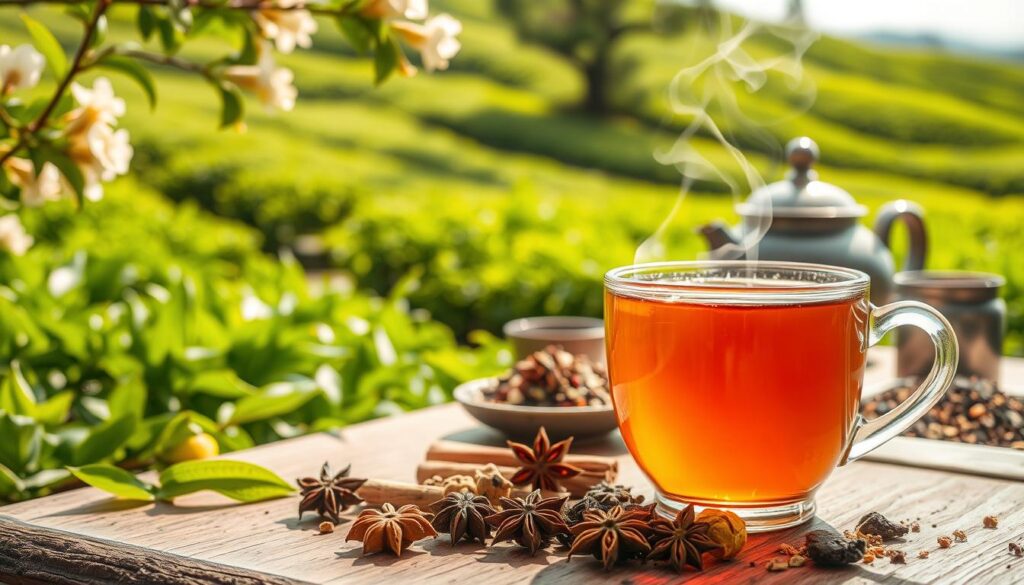
Tips for Perfecting Your Brew
To get the best taste from your tea, knowing how to brew it right is key. Start with 1-2 teaspoons of loose leaf tea for each cup of water. The steeping time should be about 5-10 minutes, depending on how strong you like your tea. If you’re up for something new, try cold brewing. It slowly pulls out the flavors in cold water over several hours.
Using the right tools can make brewing easier. Tea socks help keep leaves in place while letting the flavor seep out. It’s important to match steeping time with water temperature. Delicate teas need cooler water, about 160°F, while stronger black teas can handle boiling water. Getting your tea just right is not just about the time; it’s about making drinking it a special experience.
| Brew Type | Water Temperature | Steeping Time |
|---|---|---|
| Green Tea | 160°F – 180°F | 2 – 3 minutes |
| Black Tea | 200°F – 212°F | 4 – 5 minutes |
| Herbal Tea | 212°F | 5 – 7 minutes |
| White Tea | 160°F – 185°F | 4 – 5 minutes |
Hosting a DIY Tea Blending Party
Having a DIY tea blending party is great for creativity and making connections. Set up spots with various teas, herbs, and spices for guest-made blends. Add tea party themes that click with your friends to make it special.
Hand out a simple guide on mixing teas and spices. It helps guests make their own unique tea recipes. Adding a tea-tasting session lets everyone share and talk about their favorite blends.
Use special decorations to make your place look like a tea enthusiast’s dream. Pick colors and designs that match your tea themes. Sharing and brewing blends together makes your gathering unforgettable.
Understanding Tea Labeling and Sourcing
Getting the right tea and ingredients is key in blending. Look for trusted suppliers who care about freshness and quality. The place where tea comes from affects its taste a lot. Choose suppliers that are open about where their tea comes from. This promises great flavor and supports fair practices.
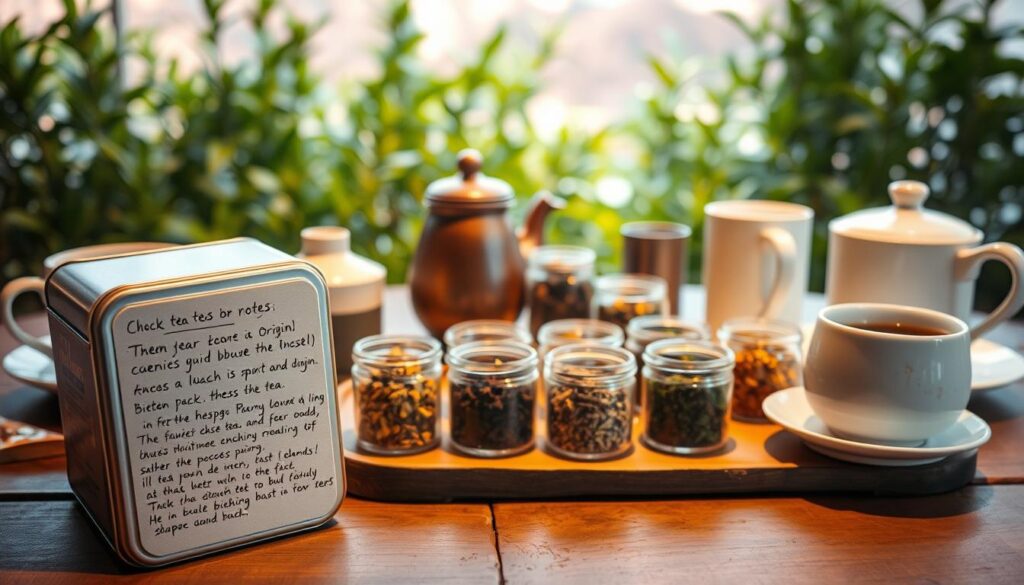
Labeling your tea correctly is very important. Your labels should have the blend’s name, what’s in it, and special traits, like taste or health perks. This is useful when sharing your tea or getting feedback. Good labels make it easier to talk about and understand your tea choices.
Putting effort into where you get your tea and how you label it improves blending. It also makes you value the craft of tea more. Caring about where your tea comes from adds to the joy of each sip.
Storing and Aging Your Blends
Storing your tea correctly is key to keeping its great taste and smell. Use these important tea storage ideas to make your blends last longer. First, pick airtight containers to cut down on oxygen contact. This helps avoid oxidation and keeps your tea fresher.
Keep your tea in a place that’s cool, dark, and dry. Light and warmth can hurt the quality of your tea. For keeping tea fresh longer, think about vacuum-sealing. This keeps the freshness in and moisture and bad smells out.
Make sure to label each container well. It helps you stay organized and makes finding your teas easier. Be careful with blends that have fresh herbs. Use these quickly for the best flavor, as their freshness fades, especially when stored for a while.
Using these suggestions will make your tea-drinking better. It makes sure every cup reminds you of the hard work you put into your blends.
Sharing Your Unique Blends
Giving out your homemade tea blends can make any event more special. It’s a beautiful way to connect. By putting them in pretty jars, you can easily gift them to your loved ones. Each jar becomes a thoughtful present with personalized labels that show your hard work and creativity.
Think about using these tea ideas for parties or holidays. They add a personal touch to any celebration and can make someone’s day brighter. Getting friends together to make tea blends is fun. It lets everyone share their mixes and learn new things, building a community of tea lovers.
Creating and sharing tea blends also brings joy to you. As you see how much others appreciate your tea, it makes the experience richer. It’s not just about the tea. It’s about building connections, exploring new ideas, and discovering more about the art of tea blending.

